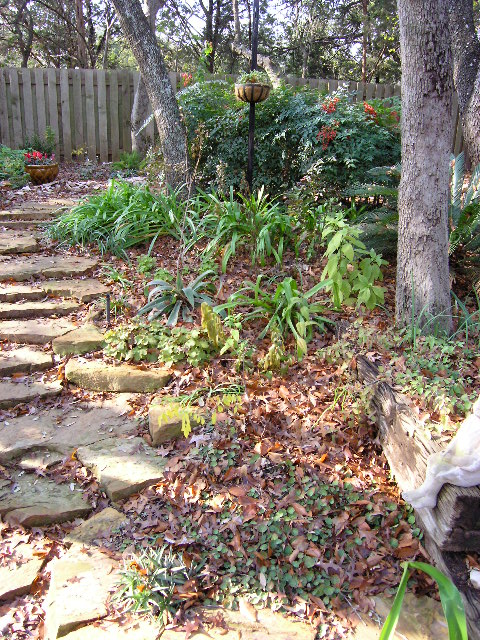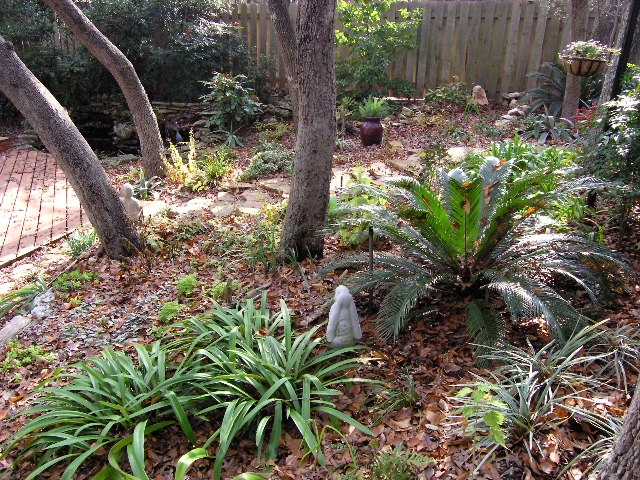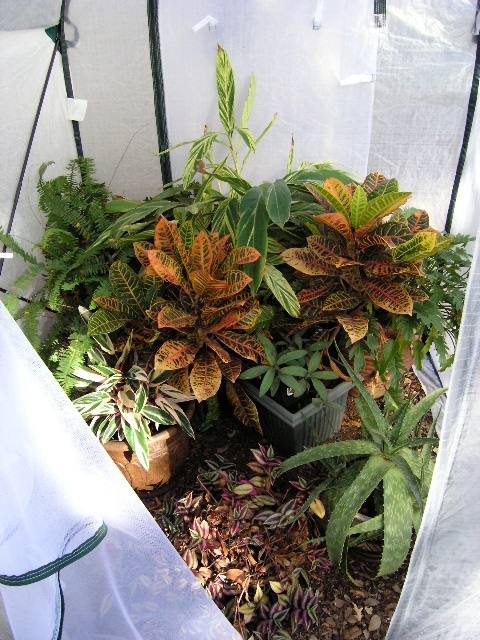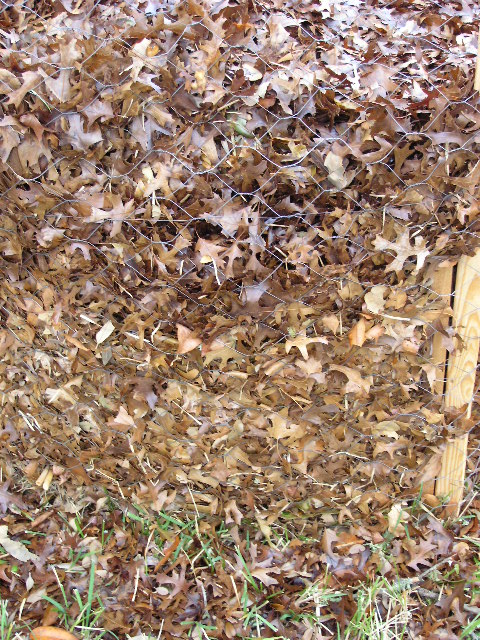Foliage Follow-up is sponsored by the Digging garden blog on the sixteenth of every month, where we get to celebrate the leafy aspects of our gardens. On this dreary, drippy day, I decided to concentrate on the few plants I have that tend to disappear in our summer's heat but make a return in the coolness of winter.
Though only starting to peak out from the leaf litter, the Sweet Kate Spiderwort (Tradescantia x andersoniana 'Sweet Kate') has begun to produce some green amongst the brown. It will primarily shine during the spring, but will fade once things get hot and dry.
Considered by many to be invasive, I threw caution to the wind this past spring and added White Shamrock (Oxalis crassipes 'Alba') to my garden. It completely disappeared in the summer, but has been coming back strong this winter.
Back in mid-September, from the bare ground, up shot my first Red Spider Lily (Lycoris radiata) bloom. I'm hoping for plenty more blossoms next fall as the bulbs are producing good foliage this winter.
After almost completely disappearing over the summer, Bear's Breech (Acanthus 'Summer Beauty') always comes on strong once the temperatures start dropping. Its huge leaves make an impressive show (though recent low temperatures have wilted the plant a little).
Another plant that is completely lacking vegetation in the summer, the Oxblood Lily (Rhodophiala bifida) is once again making its presence known. Planted only last March, I have yet to get any blooms but hope some will make an appearance this fall.
Wasn't sure if my spring-planted Heartleaf Skullcap (Scutellaria ovata) had made it through the summer heat. Winter and early spring should be its time to shine, but I'm not completely confident with it yet.
Though present year-round, the Burgundy Glow Ajuga (Ajuga reptans 'Burgundy Glow') does add quite a bit to the winter color. The burgundy coloration intensifies and spreads during the colder temperatures and makes it quite eye-catching.
Be sure to visit Digging to see the foliage that other gardeners are sharing from their winter gardens.
Sunday, January 16, 2011
Saturday, January 15, 2011
Flower Power: GBBD January 2011
On the fifteenth of every month, May Dream Gardens invites garden bloggers worldwide to share the blooms found in their garden. Obviously, the January garden will be considerably lacking compared to spring, but a few splashes of color can still be found amongst the rain showers & fallen leaves (even in my shady beds).
New Plants in the Garden
The Variegated Abutilons (Abutilon pictum 'Thompsonii') shrugged off our recent freezes and continue to put out salmon-colored blossoms.
Clusters of flowers appear at the end of the lengthy stems on the Marilyn's Choice Abutilon.
Annuals
I had read that Cyclamen (Cyclamen persicum) might not be winter-hardy (which seemed weird since this is when they are on sale), but the plants did fine without protection (though some blossoms didn't like the cold).
Potted Plants
Of my four Ground Orchids (Spathoglottis plicata), one met an untimely demise due to digging critters and two were left outside in the ground to see what winter would do to them (it smacked 'em pretty good, will have to see if they return from roots). But the potted one was moved inside & protected, where it awarded this care by producing blooms.
Flower Wannabes
This is certainly the time of year when berries steal the show; the Nandina (Nandina domestica) consistently add large clusters of bright red berries to the drab scene.
Dwarf Chinese Holly (Ilex cornuta 'Rotunda') does not consistently produce berries, but it is always nice when they make an appearance.
The leaves of the Possumhaw (Ilex decidua) have completely left the scene, allowing clusters of red berries to dominate the branches.
Only a few berries remain on the Chile Petin (Capsicum annuum var. aviculare) and those have started showing wrinkles as they age.
Last year, the show show put on by the Dwarf Buford Hollies (Ilex cornuta 'Burfordii Nana') was quite impressive, but this year, only a few small clusters of berries are present.
Hope your GBBD has been filled with color. Be sure to check out what is happening at other gardens by visiting May Dream Gardens.
New Plants in the Garden
The Variegated Abutilons (Abutilon pictum 'Thompsonii') shrugged off our recent freezes and continue to put out salmon-colored blossoms.
Clusters of flowers appear at the end of the lengthy stems on the Marilyn's Choice Abutilon.
Annuals
I had read that Cyclamen (Cyclamen persicum) might not be winter-hardy (which seemed weird since this is when they are on sale), but the plants did fine without protection (though some blossoms didn't like the cold).
Potted Plants
Of my four Ground Orchids (Spathoglottis plicata), one met an untimely demise due to digging critters and two were left outside in the ground to see what winter would do to them (it smacked 'em pretty good, will have to see if they return from roots). But the potted one was moved inside & protected, where it awarded this care by producing blooms.
Flower Wannabes
This is certainly the time of year when berries steal the show; the Nandina (Nandina domestica) consistently add large clusters of bright red berries to the drab scene.
Dwarf Chinese Holly (Ilex cornuta 'Rotunda') does not consistently produce berries, but it is always nice when they make an appearance.
The leaves of the Possumhaw (Ilex decidua) have completely left the scene, allowing clusters of red berries to dominate the branches.
Only a few berries remain on the Chile Petin (Capsicum annuum var. aviculare) and those have started showing wrinkles as they age.
Last year, the show show put on by the Dwarf Buford Hollies (Ilex cornuta 'Burfordii Nana') was quite impressive, but this year, only a few small clusters of berries are present.
Hope your GBBD has been filled with color. Be sure to check out what is happening at other gardens by visiting May Dream Gardens.
Saturday, January 8, 2011
Garden Tour: January 2011
Have seen several other garden bloggers post a series of pictures creating a tour of their garden or beds. I have never done so, and I figured its about time - if for no other reason than to provide a baseline set of pictures of the garden's present status (guess this will also have to do for my tardy December Quarterly Report).
Front Yard
Back Yard
Continuing to circle the house, one would cross the remaining side yard (home of the compost pile; very shady and consisting of only grass), exit the gate and return to the front yard. Big plans abound for numerous undeveloped areas, but the large empty areas in the existing beds still cry out for attention - so any further expansions will have to wait (likely quiet a while) until I can fill in the bare locations.
Experiment Status
Zephyr Rain Lily (Zephyranthes 'Labuffarosea') seeds: A couple still going strong.
Mahonia (Mahonia aquifolium) seeds: After sprouting and transplanting, they faded away; thinking inital germinating mixture was too heavy
Bronze Dyckia (Dyckia fosteriana) seeds: Deceased; tiny plants had difficulty rooting in loose mixture (each watering caused them to float free of soil); will have to try different mixture in future attempts
Oakleaf Hydrangea 'Alice' (Hydrangea quercifolia 'Alice') cuttings: Stayed green until last month, then dried up without ever producing any new leafs. Will have to burrow to see if any roots established.
Silver Squill (Ledebouria socialis) seeds: A couple doing really well.
Jade Plant (Crassula ovata) cuttings: Well, not cuttings - more of "oopsie, broke-offies"; started
Front Yard
- Three Tiers Garden: This narrow bed lies between my driveway and the neighbors (my yard is to the right). Dominant plants include Cast Iron Plants (Aspidistra elatior) & Soap Aloe (Aloe maculata). A few medium-sized Live Oaks provide the shade.
- Front Left Garden: Small border bed that wraps around the base of a large Red Oak and goes from the driveway to the front door entry steps. Dominant plants include Cast Iron Plants & Autumn Ferns (Dryopteris erythrosora).
- Front Right Garden: Small border bed that continues from entry steps and wraps around the corner of the house. Dominant plants include Cast Iron Plants & Boxwood (Buxus microphylla). Plan on adding a row of Autumn Ferns in front of the Cast Iron Plants (similar to the left side).
- Front Side Garden: One of the forgotten beds. Located on the left side of the house near the back yard entry gate/stone path. Dominant plants include Nandina (Nandina domestica) & Dwarf Yaupon Holly (Ilex vomitoria 'Nana'). Shade provided by Live Oaks and Yaupons (and privacy fence on two sides).
Back Yard
- Side Garden: This is the "working" aspect of the yard - that side that tends to get ignored because its where all the unattractive stuff sits (i.e. AC units, garden shed, stone piles, etc.). No windows look out upon it, so typically only seen when one happens to walk through it going from the front yard towards the larger, primary backyard area. There is a bed that borders the fence on all three sides, with another island bed containing a bird bath. Dominant plants include Mondo Grass (Ophiopogon japonicus) & Dwarf Chinese Hollies (Ilex cornuta 'Rotunda'). Shade provided by a several medium-sized Live Oaks and Yaupons (plus the privacy fence on three sides and the house on the other). But, since the large Hackberry fell this past spring, this is still considered my "sunny" garden spot.
- Pond Area: Leaving the side garden, one enters the backyard proper by rounding the corner of the house through a narrow area, stepping onto a multi-level deck that begins at ground level and extends the length of the house (ending six foot off the ground at the other corner). The first garden area one reaches is around the pond with its dual waterfalls. Dominant land plants include Dwarf Buford Hollies (Ilex cornuta 'Burfordii Nana') & Mahonia (Mahonia aquifolium); the dominant water plant is Water Poppy (Hydrocleys nymphoides). Shade provided by a very large Red Oak and some medium-sized Live Oaks.
- Path Area: A series of stone steps rise from the lower deck up to the back of the yard. Much of my energy is spent (and recharged) in the backyard garden. A considerable mixture of plants can be found in this general area, so even though there really are no dominant plants, one can find Manfreda 'Macho Mocha' (Manfreda x Mangave 'Macho Mocha'), Lily of the Nile (Agapanthus africanus), Mexican Petunias (Ruellia tweediana 'Colobe Pink') and a few Dyckia species. Shade is provided by medium to large Live Oaks & Red Oaks.
- Top of Path: The stone stairway leads one up to the highest level in the backyard. Here are some views of the top and looking back down the path towards the deck.
- Around the Bend: From the top of the steps, a path (combination decomposed granite & stone steps) bends around the corner. This back area of my garden is the least developed with most of the plants having gone into the ground in 2010. I am still pondering the possibilities for the large empty area - it receives only a small amount of dappled light during the day as it is bordered on two sides by a privacy fence (which has tall cedar growing on the other side) and sits under the canopy of several large Red Oaks, Live Oaks and a large Black Cherry tree.
- Stepping Stones Path: The path bends around and leads into a series of stepping stones that go through the middle of another large bed and lead back down towards the deck. Dominant plants include Liriope (Liriope spicata), Variegated Mondo Grass (Ophiopogon jaburan 'Vitattus') & Amaryllis 'San Antonio Rose' (Hippeastrum 'San Antonio Rose'), however, this garden is another that contains several different types of plants. Shade is provided by large Live Oaks, Red Oaks & Black Cherry tree, plus several Possumhaw trees
- End of Stepping Stones: The path is supposed to lead back to the deck, completing the circle. But presently it ends a few steps short as I continue to try varying "steps" (thus explaining the scattered flat limestone pieces). Once completed, more plants will need to be placed around the path and extending out towards the side fence in a new bed.
Continuing to circle the house, one would cross the remaining side yard (home of the compost pile; very shady and consisting of only grass), exit the gate and return to the front yard. Big plans abound for numerous undeveloped areas, but the large empty areas in the existing beds still cry out for attention - so any further expansions will have to wait (likely quiet a while) until I can fill in the bare locations.
Experiment Status
Zephyr Rain Lily (Zephyranthes 'Labuffarosea') seeds: A couple still going strong.
Mahonia (Mahonia aquifolium) seeds: After sprouting and transplanting, they faded away; thinking inital germinating mixture was too heavy
Bronze Dyckia (Dyckia fosteriana) seeds: Deceased; tiny plants had difficulty rooting in loose mixture (each watering caused them to float free of soil); will have to try different mixture in future attempts
Oakleaf Hydrangea 'Alice' (Hydrangea quercifolia 'Alice') cuttings: Stayed green until last month, then dried up without ever producing any new leafs. Will have to burrow to see if any roots established.
Silver Squill (Ledebouria socialis) seeds: A couple doing really well.
Jade Plant (Crassula ovata) cuttings: Well, not cuttings - more of "oopsie, broke-offies"; started
Tuesday, January 4, 2011
Shady Happenings
Over the past couple of weeks, my time in the garden has been limited. But I did notice a few "happenings" when I was able to be out amongst the plants.
With the cooler weather, the Bear's Breech (Acanthus 'Summer Beauty') has certainly come back from it's summer doldrums. It's pot has been hidden away under some shady Yaupons and Live Oaks where it has been busy putting out new leaves. It got moved out on to the deck so that it can be better appreciated.
The deck is pretty bare as most of the potted plants have been hidden away from the colder weather in either the garage or the new pop-up greenhouse. Though freezes have been few and light (scary ones are predicted for next week), a check on the greenhouse plants shows they are doing just fine in their new housing.
Most of the deciduous trees are now bare of leaves, but I have been busy gathering them up off my lawn by using my mulching lawnmower to shred and capture them. Each session would fill my experimental compost bin to its top, followed by it quickly settling and compacting - so that additional room was always available for the next gathering.
Noticed that this method led to varying colored strata - though the plant species' leaves gathered each time were the same. I'm just assuming that the color is more an aspect of the aging and decomposition phases.
Did find time over the holidays to build some wooden shelves for one side of my garden shed. The other side has two flimsy plastic shelves which I hope to replace with identical 3-level wooden shelves. This should increase the storage capacity of the shed and allow me to make more efficient use of its space.
Just a little bit here, and a little bit there.
With the cooler weather, the Bear's Breech (Acanthus 'Summer Beauty') has certainly come back from it's summer doldrums. It's pot has been hidden away under some shady Yaupons and Live Oaks where it has been busy putting out new leaves. It got moved out on to the deck so that it can be better appreciated.
The deck is pretty bare as most of the potted plants have been hidden away from the colder weather in either the garage or the new pop-up greenhouse. Though freezes have been few and light (scary ones are predicted for next week), a check on the greenhouse plants shows they are doing just fine in their new housing.
Most of the deciduous trees are now bare of leaves, but I have been busy gathering them up off my lawn by using my mulching lawnmower to shred and capture them. Each session would fill my experimental compost bin to its top, followed by it quickly settling and compacting - so that additional room was always available for the next gathering.
Noticed that this method led to varying colored strata - though the plant species' leaves gathered each time were the same. I'm just assuming that the color is more an aspect of the aging and decomposition phases.
Did find time over the holidays to build some wooden shelves for one side of my garden shed. The other side has two flimsy plastic shelves which I hope to replace with identical 3-level wooden shelves. This should increase the storage capacity of the shed and allow me to make more efficient use of its space.
Just a little bit here, and a little bit there.
Subscribe to:
Comments (Atom)




















































